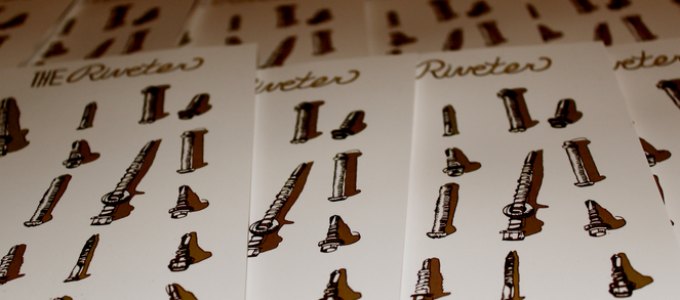
Women continue to be underrepresented in the media's workforce, but three women are changing that with a magazine dedicated to giving female writers an outlet for long-form storytelling.
by Amy Whyte
June 5, 2015
The Riveter launched in 2013 as a platform for female writers to produce long-form journalism. (Photo courtesy of The Riveter)
While studying journalism at the University of Missouri, Joanna Demkiewicz and Kaylen Ralph were about to start their futures as female journalists.
With their junior year came the announcement of the American Association of Magazine Editors 2012 awards, and the results were alarming: Not a single woman was nominated in a major writing category. It was at this moment that the pair realized the need for a long-form publication that would showcase the voices of women.

Together with Natalie Cheng, Demkiewicz and Ralph now run the Riveter, a print and online magazine dedicated to that goal. Below are edited excerpts from their interview with Diversity Executive.
Why do you believe women are underrepresented in long-form journalism?
Demkiewicz: We believe women are underrepresented in long-form journalism because they are — 2012 was an embarrassing year for female representation in print journalism. A very broad example of this is NYU’s 2012 curated list of “100 Outstanding Journalists in the United States in the Last 100 Years,” which featured 78 men and 22 women. More specifically to print journalism, in 2013, the British quarterly Port magazine published a cover story about the “new golden age” of print publishing; six white men graced the cover. A watchdog organization, VIDA: Women in Literary Arts, literally counts bylines every year and publishes the results in easy-to-read charts. These statistics call out big names like The Atlantic and The New Yorker for blatant discrepancies in gender byline breakdowns. Since the 2012 ASME blunder, VIDA has broadened its statistic umbrella to include information about women of color as well. VIDA’s 2014 count cited improvements, but we still generally see a lack of equal representation in mainstream outlets; smaller literary magazines like Crab Orchard are celebrated for publishing 57 percent women overall. Efforts like these will help change the landscape, but not until mainstream outlets welcome and celebrate the work of female writers on par with male writers will the industry truly shift to a more all-inclusive practice.
Why is it important to provide a platform for female writers?
Ralph: There are already plenty of platforms for female writers, but nothing like what The Riveter provides. The gender byline disparity, which has been tracked diligently since 2012, shows that existing outlets that provide opportunities for long-form writing don’t favor women. That leaves traditional “women’s interests” publications, which totally underestimate the breadth of women’s interests, in my opinion. The Riveter’s purpose is dual — to foster a publication that gives women writers the opportunity to challenge what the media industry has determined are women‘s most lucrative interests, and, in turn, to offer a print and online magazine that doesn’t pander to women as readers. The writers I work with every day come to us for a reason, and that’s our willingness to let these women challenge themselves professionally while challenging what the industry at large has come to expect from “women’s media.”
What advice do you have for women who feel as if they are underrepresented in their own industry?
Cheng: For me personally, it’s been pretty important to remain positive, open-minded and pick my battles. It obviously really depends on the situation — I have worked in professional scenarios where yes, I was in the minority and women were underrepresented, but any time I spoke up or pitched an idea that involved diversity and inclusion, the company was incredibly receptive. Sometimes it’s that simple — just because certain things don’t naturally occur to people that make up the “norm” of a given industry doesn’t mean they aren’t mindful or striving toward a more inclusive environment.
On the other hand, I’ve also been in some situations the people I was working with couldn’t see the benefits of an inclusive mentality and quite frankly didn’t care. In those situations, I think it can be easy to fall into a trap of negativity and dissatisfaction — but obviously that’s neither productive for an organization, nor for an individual. Of course, compromise or change comes best when all parties are open-minded and make an effort to understand the root of the disagreement, and I’ve found that achieving that open-mindedness across the board is impossible without being willing to understand where others are coming from myself. If things are truly unbearable, though, then that’s perhaps the time to seek a healthier working environment that aligns better with personal ideals.



